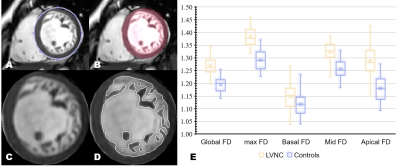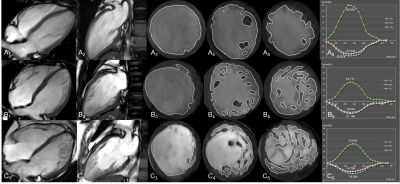4558
Correlation between LV fractal dimension and impaired strain in patients with excessive trabeculation and normal LV ejection fraction
Shiqin Yu1, Xiuyu Chen1, Kai Yang1, Jiaxin Wang1, Kankan Zhao2, Wenhao Dong1, Weipeng Yan1, and Shihua Zhao1
1Fuwai Hospital, Chinese Academy of Medical Sciences and Peking Union Medical College, Beijing, China, 2Shenzhen Institutes of Advanced Technology, Chinese Academy of Sciences, SZ University Town, Shenzhen, China
1Fuwai Hospital, Chinese Academy of Medical Sciences and Peking Union Medical College, Beijing, China, 2Shenzhen Institutes of Advanced Technology, Chinese Academy of Sciences, SZ University Town, Shenzhen, China
Synopsis
In patients with prominent excessive trabeculation, left ventricular systolic dysfunction was detected early by cardiac MRI feature tracking despite the presence of normal left ventricular ejection fraction and was associated with excessive trabecular complexity assessed by fractal dimension.
Objectives
To investigate myocardial contractility in patients with severe excessive trabeculation but normal left ventricular ejection fraction (LVEF) through feature tracking strain analysis, and the correlation between the extent of excessive trabeculation assessed by fractal dimension (FD) and myocardial contractility in patients with left ventricular noncompaction (LVNC) and normal LVEF.Methods
Forty-one LVNC patients with normal LVEF (≥50%) and 41 healthy controls were retrospectively included. All patients fulfilled three available diagnostic criteria on MRI: 1) the presence of noncompacted and compacted LV myocardium with a two-layered appearance, with at least involvement of the LV apex; 2) end-diastolic NC/C ratio >2.3 on long-axis views and ≥3 on short-axis views; 3) noncompacted mass >20% of the global LV mass. No pathologic (pressure/volume load, e.g., hypertension) or physiologic (e.g., pregnancy and vigorous physical activity) remodelling factors leading to excessive trabeculation existed. Cardiac MRI feature tracking was performed on cine images to determine left ventricular (LV) peak strains in three directions: global radial strain (GRS), global circumferential strain (GCS) and global longitudinal strain (GLS). The complexity of excessive trabeculation was quantified by fractal analysis on short-axis cine stacks.Results
Compared with controls, patients with LVNC had impaired GRS, GCS and GLS (GRS, 31.06% [27.36%, 33.84%] versus 35.92% [31.27%, 41.21%]; GCS, -18.11 ± 2.67% versus -20.24 ± 2.16%; GLS, -15.20 ± 2.25% versus -16.28 ± 2.36%; all p<0.05). The global, maximal and regional FD values of the LVNC population were all significantly higher than those of the controls (Figure 1, all p<0.05). Global FD was positively correlated with the end-diastolic volume index, end-systolic volume index and stroke volume index (r =0.483, 0.505 and 0.335, respectively, all p<0.05), but negatively correlated with GRS and GCS (r= -0.458 and 0.508, respectively, both p<0.001). Moreover, apical FD was also weakly associated with LVEF and GLS (r=-0.249 and 0.252 respectively, both p<0.05).Conclusion
In patients with LVNC, LV systolic dysfunction was detected early by cardiac MRI feature tracking despite the presence of normal LVEF and was associated with excessive trabecular complexity assessed by FD.Acknowledgements
No acknowledgement found.References
No reference found.Figures

Fractal analysis. (A)
Region of interest (ROI) allocation; (B) ROI confirmation; (C)
ROI segmentation; (D) Outline identification; (E) Global and
regional fractal dimension (FD) values of patients with left
ventricular noncompaction (LVNC) and healthy controls.

Representative
examples of healthy control (cluster A) and patients with different degrees of
excessive trabeculation (cluster B-C): cine images at end diastole (A1-2, B1-2,
C1-2); basal, medial, apical fractal dimension (A3-5, 1.054, 1.206, 1.156;
B3-5, 1.094, 1.407, 1.448; C3-5, 1.116, 1.403, 1.511); global radial strain
(GRS), global circumferential strain (GCS) and global longitudinal strain (GLS)
(A6, B6, C6)
DOI: https://doi.org/10.58530/2022/4558